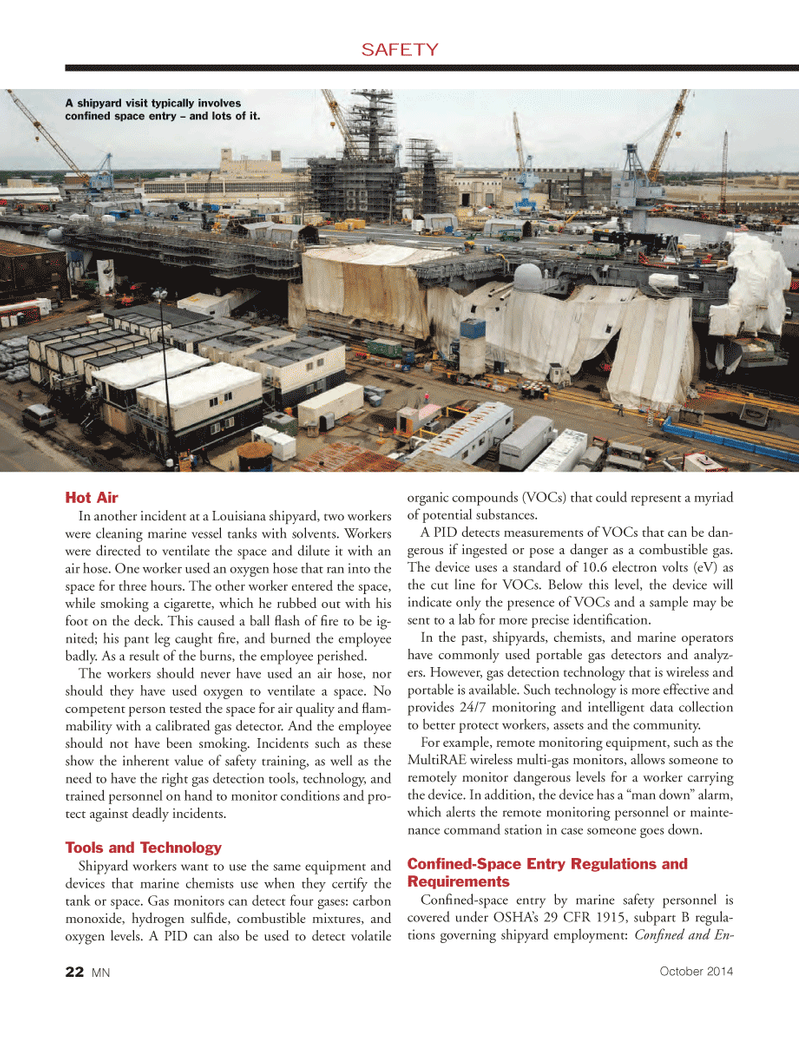
Page 22: of Marine News Magazine (October 2014)
Innovative Products & Boats - 2014
Read this page in Pdf, Flash or Html5 edition of October 2014 Marine News Magazine
Hot Air
In another incident at a Louisiana shipyard, two workers were cleaning marine vessel tanks with solvents. Workers were directed to ventilate the space and dilute it with an air hose. One worker used an oxygen hose that ran into the space for three hours. The other worker entered the space, while smoking a cigarette, which he rubbed out with his foot on the deck. This caused a ball fl ash of fi re to be ig- nited; his pant leg caught fi re, and burned the employee badly. As a result of the burns, the employee perished.
The workers should never have used an air hose, nor should they have used oxygen to ventilate a space. No competent person tested the space for air quality and fl am- mability with a calibrated gas detector. And the employee should not have been smoking. Incidents such as these show the inherent value of safety training, as well as the need to have the right gas detection tools, technology, and trained personnel on hand to monitor conditions and pro- tect against deadly incidents.
Tools and Technology
Shipyard workers want to use the same equipment and devices that marine chemists use when they certify the tank or space. Gas monitors can detect four gases: carbon monoxide, hydrogen sulfi de, combustible mixtures, and oxygen levels. A PID can also be used to detect volatile organic compounds (VOCs) that could represent a myriad of potential substances.
A PID detects measurements of VOCs that can be dan- gerous if ingested or pose a danger as a combustible gas.
The device uses a standard of 10.6 electron volts (eV) as the cut line for VOCs. Below this level, the device will indicate only the presence of VOCs and a sample may be sent to a lab for more precise identifi cation.
In the past, shipyards, chemists, and marine operators have commonly used portable gas detectors and analyz- ers. However, gas detection technology that is wireless and portable is available. Such technology is more effective and provides 24/7 monitoring and intelligent data collection to better protect workers, assets and the community.
For example, remote monitoring equipment, such as the
MultiRAE wireless multi-gas monitors, allows someone to remotely monitor dangerous levels for a worker carrying the device. In addition, the device has a “man down” alarm, which alerts the remote monitoring personnel or mainte- nance command station in case someone goes down.
Confi ned-Space Entry Regulations and
Requirements
Confi ned-space entry by marine safety personnel is covered under OSHA’s 29 CFR 1915, subpart B regula- tions governing shipyard employment: Confi ned and En-
SAFETY
A shipyard visit typically involves confi ned space entry – and lots of it. 22 MN
October 2014
MN Oct14 Layout 18-31.indd 22 9/18/2014 3:28:40 PM

 21
21

 23
23
